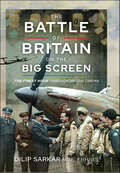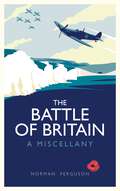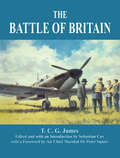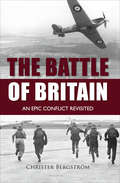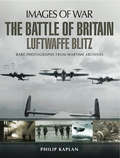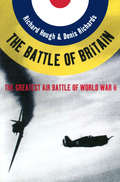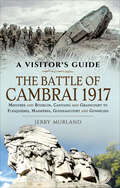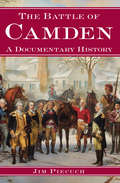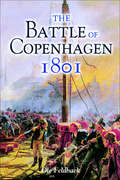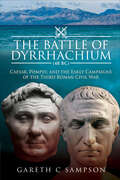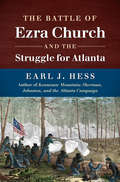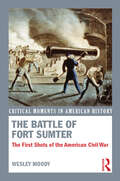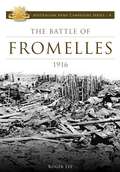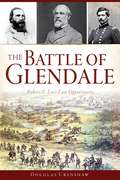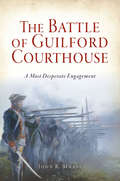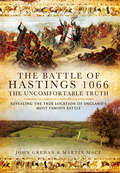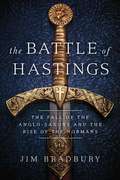- Table View
- List View
The Battle of Britain in the Modern Age, 1965–2020: The State’s Retreat and Popular Enchantment
by Garry CampionThe Battle of Britain has held an enchanted place in British popular history and memory throughout the modern era. Its transition from history to heritage since 1965 confirms that the 1940 narrative shaped by the State has been sustained by historians, the media, popular culture, and through non-governmental heritage sites, often with financing from the National Lottery Heritage Lottery Fund. Garry Campion evaluates the Battle’s revered place in British society and its influence on national identity, considering its historiography and revisionism; the postwar lives of the Few, their leaders and memorialization; its depictions on screen and in commercial products; the RAF Museum’s Battle of Britain Hall; third-sector heritage attractions; and finally, fighter airfields, including RAF Hawkinge as a case study. A follow-up to Campion’s The Battle of Britain, 1945–1965 (Palgrave, 2015), this book offers an engaging, accessible study of the Battle’s afterlives in scholarship, memorialization, and popular culture.
The Battle of Britain on the Big Screen: ‘The Finest Hour' Through British Cinema
by Dilip SarkarDuring the Second World War, the British movie industry produced a number of films concerning the war, all of which were, by necessity, heavily myth-laden and propagandised. Foremost among these productions was The First of the Few, which was the biggest grossing film of 1942. In the immediate post-war period, to start with there were no British aviation war films. The first to be released was Angels One Five in 1952. It was well-received, confirming that the Battle of Britain was a commercial commodity. Over the next few years, many famous war heroes published their memoirs, or had books written about them, including the legless Group Captain Douglas Bader, whose story, Reach for the Sky, told by Paul Brickhill, became a best-seller in 1956. It was followed a year later by the film of the same name, which, starring Kenneth More, dominated that year’s box office. The early Battle of Britain films had tended to focus upon the story of individuals, not the bigger picture. That changed with the release of the star-studded epic Battle of Britain in 1969. Using real aircraft, the film, produced in color and on a far larger scale than had been seen on film before, was notable for its spectacular flying sequences. Between the release of Reach for the Sky and Battle of Britain, however, much had changed for modern Britain. For a variety of reasons many felt that the story of the nation’s pivotal moment in the Second World War was something best buried and forgotten. Indeed, the overall box office reaction to Battle of Britain reinforced this view – all of which might explain why it was the last big screen treatment of this topic for many years. It was during the Battle of Britain’s seventieth anniversary year that the subject returned to the nation's screens when Matthew Wightman’s docudrama First Light was first broadcast. Essentially a serialisation of Spitfire pilot Geoffrey Wellum’s best-selling memoir of the same title, Wightman cleverly combined clips of Wellum as an old man talking about the past with his new drama footage. The series is, in the opinion of the author, the best portrayal of an individual’s Battle of Britain experience to have been made. In this fascinating exploration of the Battle of Britain on the big screen, renowned historian and author Dilip Sarkar examines the popular memory and myths of each of these productions and delves into the arguments between historians and the filmmakers. Just how true to the events of the summer of 1940 are they, and how much have they added to the historical record of ‘The Finest Hour’?
The Battle of Britain, 1945–1965: The Air Ministry And The Few
by Garry CampionSeventy-five years after the Battle of Britain, the Few's role in preventing invasion continues to enjoy a revered place in popular memory. The Air Ministry were central to the Battle's valorisation. This book explores both this, and also the now forgotten 1940 Battle of the Barges mounted by RAF bombers.
The Battle of Britain: A Miscellany
by Norman FergusonHave you ever wondered...• How fast a Spitfire could travel?• Which pilot won Fighter Command’s only Victoria Cross?• What a ‘Stuka Party’ was?Telling the stories of the commanders, the air raids, the pilots, the aircraft and the vital use of the world’s first radar air defence system, this comprehensive miscellany is a compelling guide to this most crucial of Second World War battles – the first to be fought solely in the air.
The Battle of Britain: A Miscellany
by Norman FergusonHave you ever wondered...• How fast a Spitfire could travel?• Which pilot won Fighter Command’s only Victoria Cross?• What a ‘Stuka Party’ was?Telling the stories of the commanders, the air raids, the pilots, the aircraft and the vital use of the world’s first radar air defence system, this comprehensive miscellany is a compelling guide to this most crucial of Second World War battles – the first to be fought solely in the air.
The Battle of Britain: Air Defence of Great Britain, Volume II (Royal Air Force Official Histories #Vol. 2)
by T.C.G. JamesThis is the second volume of the classified history of air defence in Great Britain. Written while World War II was still being fought, the account has an analysis of the defensive tactics of Fighter Command, and attempts a day-by-day analysis of the action as it took place.
The Battle of Britain: An Epic Conflict Revisited
by Christer BergströmA thorough look at this turning-point WWII aerial battle, with eyewitness accounts, maps, and rare photos: &“incredibly well-researched&” (Aircrew Book Review). By late summer 1940, Nazi Germany had conquered all its opponents on the continent, including the British Army itself, which was forced to scramble back aboard small boats to its shores. A non-aggression pact with the Soviet Union in hand, Hitler had only one remaining object that season—the British Isles themselves. However, before he could invade, his Luftwaffe needed to wipe the Royal Air Force from the skies. History&’s first strategic military campaign conducted in the air alone was about to take place. This book contains a large number of dramatic eyewitness accounts, even as it reveals new facts that will alter common perceptions of the battle. For example, the twin-engined Messerschmitt Bf 110 was actually a good day fighter, and it performed at least as well in this role as the Bf 109 during the battle. The Luftwaffe&’s commander, Hermann Göring, performed far better than has been believed. The British night bombers played a more decisive role than previously thought; in addition, this book disproves that the German 109 pilots were in any way superior to their Hurricane or Spitfire counterparts. The author has examined records from both sides and provides surprising statistics that shatter much conventional wisdom—laying out the Battle of Britain as seldom seen before. Includes color photos of the relevant aircraft.
The Battle of Britain: Rare Photographs From Wartime Archives (Images of War)
by Philip KaplanThis new collection of archive imagery from Philip Kaplan offers a gripping, graphic view of the routine repeated each day and night, from the summer of 1940 through to the following spring, by the German bomber crews bringing their deadly cargoes to Britain. Through mainly German archival photos, it profiles airmen on their French bases and in the skies over England; the aircraft they flew, fought and sometimes died in; their leaders; their targets and results; the R.A.F pilots and aircraft that stood in opposition to the German forces, and the losses experienced on both sides. The images, from the Bundesarchiv and other German and British photographic sources, vividly convey a real sense of events as they played out, as do the compelling first-hand accounts from a host of participants on both sides, eyewitnesses to one of the most brutal sustained bombardments of the Second World War.
The Battle of Britain: The Greatest Air Battle of World War II
by Denis Richards Richard Alexander Hough<P> A definitive account of the three-month air battle in 1940 between the Royal Air Force and the Luftwaffe. <P> The victory of the Battle of Britain ranks with Marathon and the Marne as a decisive point in history. At the end of June 1940, having overrun much of Western Europe, the Nazi war leaders knew that they had to defeat the Royal Air Force Fighter Command before they could invade the British mainland. With a finely-struck balance of historical background and dramatic renderings of RAF and Luftwaffe engagements over the English countryside, Hough and Richards offer a history that is at once deep and wide-ranging. <P> They offer insight into how the British laid the groundwork for victory through aircraft research and production, the development and implementation of command and control structures, and research into new technologies, the most important of which was radar. Hough and Richards also utilize first-person accounts of the battle whenever possible, rendering the battle scenes with cinematic intensity. A compelling introduction to one of the most important battles of World War II, The Battle of Britain pays tribute to the men about whom Winston Churchill would remark, "Never in the field of human conflict was so much owed by so many to so few."
The Battle of Cambrai 1917: Mœuvres and Bourlon, Cantaing and Graincourt to Flesquières, Masnières, Gouzeaucourt and Gonnelieu
by Jerry MurlandThe 1917 Battle of Cambrai featured the first massed tank attack in military history and provoked the biggest German counter-attack against the British since 1914. The British aimed to break through the German Hindenburg Line, then threaten the rear of the German positions to the north. The battle is one of the most famous and controversial episodes of the First World War, and the battlefield is one of the most commonly visited on the Western Front. Jerry Murland’s clearly written, highly illustrated guide is the ideal introduction to it. Visitors can trace for themselves the course of the battle across the modern landscape and gain a fascinating insight into the nature of the fighting – and the wider conflict across the Western Front – throughout the war. Included are a series of routes that can be walked, cycled or driven. Among the key sites covered are Haverincourt, Flesquières, Mœuveres, Graincourt, Cantaign, Marcoing and Masnières, Bourlon, La Vacquerie and Villers-Plouich, Gouzeaucourt and Gonnelieu. In each place Jerry Murland describes the fighting that occurred there, recording what happened, exactly where it happened and why, and he points out the sights that remain for the visitor to see. His guidebook is essential reading for visitors who wish to enhance their understanding of the Battle of Cambrai and the war on the Western Front.
The Battle of Camden: A Documentary History
by Jim PiecuchFirst-person accounts and historical analyses of this dramatic Revolutionary War battle in South Carolina. On the foggy morning of August 16, 1780, American and British armies clashed in the pine woods north of Camden, South Carolina, in one of the most important and influential battles of the Revolutionary War. An American victory would quash British plans to subjugate the southern colonies and virtually guarantee the independence of the fledgling United States. A victory for the British would pave the way for the conquest of North Carolina and Virginia. After nearly an hour of frenzied, bloody combat, the British army emerged victorious, and American morale plummeted to its lowest point of the war. The rout at Camden was not a total loss, however—as Patriot forces eventually came away with a renewed determination to resist British advances, and the lessons from the defeat were applied to secure future victories that finally allowed the Patriots to triumph in the South. This book presents the Battle of Camden as never before: through the words of American and British participants and contemporary observers. The events leading up to the conflict, the combat itself, and the consequences of Camden are all described in striking detail. The cunning strategies of both American Major General Horatio Gates and British Lieutenant General Lord Cornwallis are revealed, as are a number of battlefield reports from soldiers on both sides. In addition to these compelling first-hand accounts, The Battle of Camden includes analysis of the battle and its effects in America and Europe from George Washington, Thomas Jefferson, and Lord George Germain. With this landmark text, historian Jim Piecuch offers a comprehensive consideration of a vital Revolutionary battle and its effects on the war for American independence.
The Battle of Copenhagen, 1801: Nelson's Historic Victory
by Ole FeldbaekA leading Danish historian presents a detailed account of the epic naval conflict between Denmark and a British fleet led by Vice Admiral Nelson. Fearing an alliance between Denmark and France, Britain sent a fleet of more than fifty ships to form a blockade off Great Yarmouth to prevent collaboration and ensure its naval superiority. But a series of diplomatic failures sent Vice Admiral Horatio Nelson into battle at Copenhagen. Written by the leading Danish authority on the period, this splendid work brings to life Nelson&’s historic victory immortalized by his so famously turning a blind eye to his superior&’s order to halt operations. As well as describing the brilliance of the British tactics, the work fascinatingly reveals the desperate action and great bravery displayed by the Danish defenders who suffered appallingly in the fighting.
The Battle of Crete (Australian Army Campaigns #1)
by Albert PalazzoBetween 20 May and 1 June 1941 the Second World War came to the Greek island of Crete. The Commonwealth defenders consisted of Australian, New Zealand and British refugees from the doomed Greek Campaign who had not recovered from defeat.
The Battle of Dorking: Reminiscences Of A Volunter
by George Tomkyns ChesneyBritain is under attack, and winning at Dorking is the only way the empire can be saved It is the late nineteenth century, and a country much like Germany is on the move in Europe. It has already beaten its rivals on the continent and mobilized to the Netherlands, provoking the fear of British citizens. Then the nation strikes. Its powerful weapons destroy the Royal Navy, and invasion cannot be far behind. Written as a hypothetical exercise to raise awareness among average British citizens about the potential danger that a resurgent Germany could pose, The Battle of Dorking earned its place in literary history as the forerunner to the invasion-novel genre, predating The War of the Worlds by almost twenty years. The novel&’s drama, which culminates in a fight that will change the course of history forever, thrilled audiences when it was originally released as a serial, and it maintains its power today. This ebook has been professionally proofread to ensure accuracy and readability on all devices.
The Battle of Dyrrhachium, 48 BC: Caesar, Pompey, and the Early Campaigns of the Third Roman Civil War
by Gareth C. SampsonIn 49 BC the Roman Republic collapsed once more into bloody civil war. At the heart of this war lay the two greatest living Roman commanders, and former allies, Pompey the Great and Julius Caesar, each having built their own factions within the Roman oligarchy and refusing to compromise. The subsequent civil war would be fought for control of the Republic with each man determined to restore peace and stability to Rome, under their leadership. Yet despite this clash it was eighteen months before the two men met in Battle at Dyrrhachium in Albania. Gareth Sampson outlines the strategic background, describing the early campaigns of the civil war and the factions of Caesar and Pompey that fought for control of the vast resources of the Republic. The Battle of Dyrrhachium itself is analysed to determine the strengths and weakness of both armies and their various commanders as well as the tactics used in the phases of the battle which culminated in victory for Pompey. Focus is also given to the aftermath of the battle that saw Caesar defeated and Pompey in the ascendancy.
The Battle of Ezra Church and the Struggle for Atlanta (Civil War America)
by Earl J. HessFought on July 28, 1864, the Battle of Ezra Church was a dramatic engagement during the Civil War's Atlanta Campaign. Confederate forces under John Bell Hood desperately fought to stop William T. Sherman's advancing armies as they tried to cut the last Confederate supply line into the city. Confederates under General Stephen D. Lee nearly overwhelmed the Union right flank, but Federals under General Oliver O. Howard decisively repelled every attack. After five hours of struggle, 5,000 Confederates lay dead and wounded, while only 632 Federals were lost. The result was another major step in Sherman's long effort to take Atlanta.Hess's compelling study is the first book-length account of the fighting at Ezra Church. Detailing Lee's tactical missteps and Howard's vigilant leadership, he challenges many common misconceptions about the battle. Richly narrated and drawn from an array of unpublished manuscripts and firsthand accounts, Hess's work sheds new light on the complexities and significance of this important engagement, both on and off the battlefield.
The Battle of Fontenoy 1745: Saxe against Cumberland in the War of the Austrian Succession
by James FalknerA detailed history of a pivotal, bloody battle in a clash of European dynasties, with illustrations included. The Battle of Fontenoy marked a turning point in the War of the Austrian Succession, yet it has rarely been analyzed in depth and the Europe-wide conflict in which it played a part is little understood. James Falkner, in this perceptive and original account, puts the record straight by describing the fighting in graphic detail and setting it in the context of the sequence of wars that determined the shape of Europe during the eighteenth century. Great Britain, with her Austrian and Dutch allies, fought to ensure that Maria Theresa of Austria should be able to take the throne of the Holy Roman Empire. Ranged against her interests was the might of Louis XV's France, which strove to weaken Austria by promoting a Bavarian aspirant to the Imperial throne. On May 11, 1745 at Fontenoy in the Austrian Netherlands, the two sides met in a ferocious daylong struggle that changed the course of the war. James Falkner&’s narrative gives a fascinating insight into the Battle of Fontenoy itself and more widely into the nature of warfare in Europe more than 250 years ago.
The Battle of Fort Sumter: The First Shots of the American Civil War (Critical Moments in American History)
by Wesley MoodyOn April 12, 1861, the long-simmering tensions between the American North and South exploded as Southern troops in the seceding state of South Carolina fired on the Federal forces at Fort Sumter in Charleston harbor. The battle of Fort Sumter marked the outbreak of Civil War in the United States. The attack provoked outrage in the North, consolidated support for the newly inaugurated President Lincoln, and fueled the onset of the war that would consume and reshape the country. In this concise narrative, Wesley Moody explores the long history of tensions that lead to the events at Fort Sumter, the details of the crisis and battle, the impact of Fort Sumter on the unfolding Civil War, and the battle's place in historical memory. Supplemented by primary documents including newspaper coverage, first-person accounts, letters, and government documents, and supported by a companion website, this book provides students with a nuanced understanding of both the long-term and immediate origins of the American Civil War.
The Battle of Fromelles 1916: A Case Study Of An Evolving Skill (Australian Army Campaigns #8)
by Roger LeeThe Battle of Fromelles remains the single bloodiest day in terms of soldiers killed, wounded or missing, in Australia's military history. Remains of soldiers were recently discovered in mass graves in northern France and the final soldier will be laid to rest when a new cemetery officially opens on 19th July, 2010 - the 94th anniversary of the battle.
The Battle of Gettysburg [Illustrated Edition]
by Franklin Aretas HaskellIncludes 30 maps and plans to illustrate the bloody engagement at Gettysburg.Originally published as a 72-page pamphlet for private circulation only, and then first published in full print in 1908, this story of the Battle of Gettysburg was written by Lieutenant Haskell to his brother, H. M. Haskell of Portage, not long after the contest .Although not originally intended for publication, its great merit was at once recognized, and the account was widely read by military experts, and received much praise for both its literary and its professional merit.
The Battle of Gettysburg: A Soldier's First-Hand Account (Civil War)
by Frank A. HaskelThe bloody, three-day battle of Gettysburg in the summer of 1863 resulted in thousands of casualties on both sides. Considered the turning point of the Civil War, the campaign rallied the Union troops. A few weeks after the epic military confrontation, Colonel Frank Haskell, a member of the Army of the Potomac, wrote his brother in Wisconsin a highly moving account of what he had experienced. It was perhaps the longest, most poignant letter to a relative from a soldier in the Civil War. Some 45 years later, his comments appeared in book format; this volume is a reprint of that rare edition. In this keenly observed narration, Haskell vividly describes each day's events and what they wrought: the wounded, the skirmishes, attacks and counterattacks, estimates of losses, marks of battle, and burial of the dead. Of the crests in Gettysburg known as Cemetery Ridge, he writes: "Men looked like giants there in the mist, and the guns of the frowning batteries so big, that it was a relief to know that they were our friends." On the second day of battle, he lost his horse "Billy" to a bullet that just missed Haskell's left leg. Mentally, he "begged [Billy's] pardon for spurring him." On the last day, he notes: "The Rebel guns make no reply to ours, no charging shout rings out to-day . . . the jostling, swaying lines on either side boil, and roar, and dash their flamy spray, two hostile billows of a fiery ocean. . . . The frequent dead and wounded lie where they stagger and fall . . . and none can be spared to care for them." He helped bury the dead that day and ended his letter on a note of hope, speaking of a future in which the Union would "repose in a securer peace and bloom in a higher civilization." Almost a year later — on June 3, 1864, at Cold Harbor, Virginia — Colonel Haskell was killed in action. He was 36 years old. One of the war's best eyewitness accounts, this classic narrative, required reading for students of American history, will be treasured by Civil War buffs.
The Battle of Glendale: Robert E. Lee’s Lost Opportunity (Civil War Series)
by Douglas CrenshawBy late June 1862, the Union army, under George B. McClellan, stood at the doorstep of Richmond. In a desperate hour for the Confederate capital, Robert E. Lee attacked McClellan and drove the Union army into a full retreat toward the safety of the James River. Lee recognized an opportunity to seal a decisive victory and commanded his Army of Northern Virginia to prevent the Union forces from retreating. A.P. Hill, James Longstreet and “Stonewall” Jackson were among those who engaged in the harrowing day of battle during the Seven Days’ Campaign. Author Douglas Crenshaw details the dramatic Battle of Glendale in the Civil War.
The Battle of Guilford Courthouse: A Most Desperate Engagement (Military)
by John R. MaassAround the North Carolina village of Guilford Courthouse in the late winter of 1781, two weary armies clashed on a cold, wet afternoon. American forces under Nathanael Greene engaged Lord Cornwallis's British army in a bitter two-hour battle of the Revolutionary War. The frightful contest at Guilford was a severe conflict in which troops made repeated use of their flintlock muskets, steel bayonets and dragoon swords in hand-to-hand fighting that killed and wounded about eight hundred men. Historian John R. Maass recounts the bloody battle and the grueling campaign in the South that led up to it, a crucial event on the road to American independence.
The Battle of Hastings 1066: Revealing the True Location of England’s Most Famous Battle
by John GrehanThe Battle of Hastings is the most defining event in English history. As such, its every detail has been analyzed by scholars and interpreted by historians. Yet one of the most fundamental aspect of the battle the place upon which it was fought has never been seriously questioned, until now. Could it really be the case that for almost 1,000 years everyone has been studying the wrong location? In this in-depth study, the authors examine the early sources and the modern interpretations to unravel the compulsive evidence that historians have chosen to ignore because it does not fit the traditional view of where the battle was fought. Most importantly, the authors investigate the terrain of the battlefield and the archaeological data to reveal exactly where history was made.
The Battle of Hastings: The Fall of the Anglo-Saxons and the Rise of the Normans (Military History Ser.)
by Jim BradburyA rousing historical narrative of the best-known and arguably most significant battle in English history. The effects of the Battle of Hastings were deeply felt at the time, causing a lasting shift in British cultural identity and national pride. Jim Bradbury explores the full military background of the battle and investigates both what actually happened on that fateful day in 1066 and the role that the battle plays in the British national myth. The Battle of Hastings starts by looking at the Normans—who they were, where they came from—and the career of William the Conqueror before 1066. Next, the narrative turns to the Saxons in England, and to Harold Godwineson, successor to Edward the Confessor, and his attempts to create unity in the divided kingdom. This provides the background to an examination of the military development of the two sides up to 1066, detailing differences in tactics, arms, and armor. The core of the book is a move-by-move reconstruction of the battle itself, including the advance planning, the site, the composition of the two armies, and the use of archers, feigned retreats, and the death of Harold Godwineson. In looking at the consequences of the battle, Jim Bradbury deals with the conquest of England and the ongoing resistance to the Normans. The effects of the conquest are also seen in the creation of castles and developments in feudalism, and in links with Normandy that revealed themselves particularly in church appointments. This is the first time a military historian has attempted to make accessible to the general reader all that is known about the Battle of Hastings and to present as detailed a reconstruction as is possible. Furthermore, the author places the battle in the military context of eleventh-century Europe, painting a vivid picture of the combatants themselves—soldiery, cavalry, and their horses—as they struggled for victory. This is a book that any reader interested in England&’s history will find indispensable.

